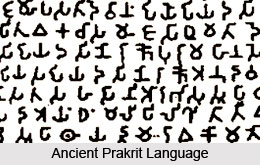 Prakrit language, according to one interpretation is variously translated as being "original, natural, artless, normal, ordinary, usual", and is also interpreted as indicating the "vernacular". With advancement, the Prakrit became literary language, principally patronised by kings delineating the Kshatriya caste, but were regarded as out-and-out illegitimate by the Brahmin dogmatism and orthodoxy. The earliest surviving usage of Prakrit is the corpus of inscriptions of emperor Ashoka.
Prakrit language, according to one interpretation is variously translated as being "original, natural, artless, normal, ordinary, usual", and is also interpreted as indicating the "vernacular". With advancement, the Prakrit became literary language, principally patronised by kings delineating the Kshatriya caste, but were regarded as out-and-out illegitimate by the Brahmin dogmatism and orthodoxy. The earliest surviving usage of Prakrit is the corpus of inscriptions of emperor Ashoka.
History of Prakrit Language
Instances like Gunadhya`s Baddakaha or Brhatkatha (possibly 1st or 2nd century A.D.), Hal`s Gahasattasai or Gathasaptashati (possibly 2nd or 3rd century A.D.) and Bakpatiraj`s Gaudbaho or Gaudabadh (8th century), serve as the best and most intellectual sections for Prakrit language. The period of the tremendous rise, further rise and predominance of Prakrit is generally acknowledged as being from the 6th - 5th centuries B.C. to the 11th century A.D.
Types of Prakrit Language
Prakrit language, since ancient times had witnessed sufficient metamorphosis, with transition of time making it gets divided into substantial sections. The three `Dramatic Prakrits` comprising Sauraseni, Magadhi, Maharashtri, as well as Jain Prakrit, each embodying and symbolising a divergent tradition of literature, encompassed within the history of India.
There were three stages in the evolution of Prakrit; ancient or oral Prakrit, literary Prakrit and Apabhramsa-Abahattha. The first stage existed from the 5th-6th century B.C. to the 1st century A.D. The second stage lasted from the 1st to the 6th century A.D. During this period, different forms of Prakrit Language were used to write books as well as the dialogues of low characters in Sanskrit plays. The third stage flourished from the 6th to the 11th century A.D. This was followed by the appearance of various modern languages. But Prakrit continued to be used alongside the newer languages until the 15th century.
Literary works of Prakrit Language
The utilisation of Prakrit language for purposes of penning significant texts can be identified by the 5th century, when secular books as well works associated with the Jain religion were composed. The cardinal scripture of the Jains, Agamshastra or Siddhanta (Ayarangasutta, Suyakadangasutta etc), bearing the words of the Jain sage, Lord Mahavira, was composed before the termination of the 5th century. Commentaries on Agamsastra such as Nijjutti, Chunni, Paumchariam (Jain Ramayana) and Harivangshapurana (Jain Mahabharata), as well as miscellaneous biographies of Jain acharyas (preceptors) and tirthankars (monks) were also scripted approximately around this time.
Secular Prakrit literature, compiling the salient points of Prakrit language, entirely reflected the lives of the common mass. This literature can be further sub-divided into five classes, comprising of dialogue and lyrics in Sanskrit plays, epics, moral poems, historical poems and narrative poems based upon legends.
Noteworthy amongst epics in Prakrit language comprises of Prabar Sen`s Ravanbaho or Ravanbadh (5th-6th century), Bakpatiraj`s Gaudbaho or Gaudabadh (8th century), Puspadanta`s (10th century) Jasaharchariu and Naykumarchariu or Nagkumarcharita, Gunchandra Gani`s Mahavirchariya or Mahavircharita (11th century), Kouhal`s Lilavaikaha or Lilavatikatha and Hemchandra`s Kumarpalchariya or Kumarpalcharita (12th century)
Prakrit Poetry
Considered eminent on the list of historical poems in Prakrit language comprises of the epics Gaudabaho, Lilavaikaha and Kumarpalchariya. Jinprabha Suri`s Tirthakalpa might just also be encompassed in the genre of historical poems, due to its bearing the names of numerous kings.
Kathanak are poems based upon folktales scripted in Prakrit language. The first of such books can be witnessed in Bhabadev Suri`s Kalkacharya Kathanak, compiled in a concoction of prose and verse. Some other books in this genre include Shrishchandra`s Kathakos (12th century), Somchandra`s Kathamahabodhi (15th century) and Gunadya`s Baddakaha.
An assortment of prose works were also scripted in Prakrit language, such as narratives, plays, grammar books, dictionaries, books on prosody, astrology and philosophy. Some authoritative books in this genre include Basudevhindi by Sanghadas and Dharmasen Gani and Haribhadra Suri`s Samaraichchakaha (Samaradityakatha). Some Prakrit plays worth citing are Rajshekhar`s Karpurmanjari (10th century), Rudradas` Chandralekha (17th century) and Bishveshvar`s Srngarmanjari (18th century).
But succeeding works like Bararuchi`s Prakrtprakash, Hemchandra`s Shabdanushasan, Trivikram`s Prakrta Byakaran and Markendeya`s Prakrtsarbasva deserve a singular position in history of Prakrit language. Hem Chandra indeed does occupy an exceptional place in penning Prakrit grammar. The only two dictionaries worth a special mention include Dhanapal`s Paiyalachchhi-Nammala (10th century) and Hemchandra`s Deshi-Nammala (12th century).
Prakrit Prosody
Prakrit prosody was pretty much developed since its inception. There existed a number of books in Prakrit on prosody, the most important being Pingal`s Prakrtpaingal, which encompasses discussions of both Prakrit and Apabhramsa metres. The influence of Prakrit metres on the growth and evolution of Bengali poetry was more pronounced. Most philosophical works in Prakrit language are dedicated to Jain philosophy. Three celebrated philosophical works of the 1st to 2nd centuries comprise Prabachansar, Niyamsar and Panchastikayasar.



















